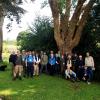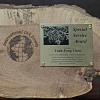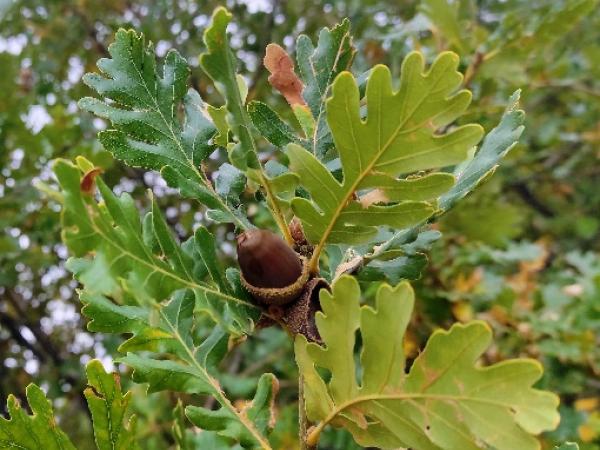Editor's Picks
Plant Focus
Additional Notes on a Very Special Oak

I wrote the report of the second Post-Conference Tour on this website, a Tour that took us from Cupertino to Los Angeles. I had a lot of notes and recordings that could not fit in the trip report. That's why some of it is published in this blog entry, which focuses on Quercus engelmannii, the Engelmann or mesa oak. Most of the last day of the second Post-Conference Tour was to be devoted to this tree. We had seen a fine specimen of the species at the Santa Barbara Botanic Garden on the previous day. Upon arrival in Arcadia, our first, very brief, stop was on Fallen Leaf Road . Some of the trees lined along the street are Q. engelmannii. These trees were there before the area was developed and they have survived along the street but also apparently in some of the gardens, and this despite the watering systems intensively used in the area to maintain perfectly green lawns. Unfortunately, we were not given the time to walk along the road to have a serious look at the trees. We were pressed to board the vans to drive to the Los Angeles County Arboretum and Botanic Garden. Note that the Engelmann Oak Grove at the Arboretum was clearly one of the highlights of the Tour.

The arboretum covers 127 acres. Our guide for the day was Jim Henrich, curator of living collections. We were here to see a grove of Engelmann Oaks that predates the arboretum and that is being preserved and actively managed. On our way through, we saw a couple of striking trees. The first one is a eucalyptus. I know that these trees have a bad reputation. But this one had a spectacular bark: Eucalyptus deglupta. It had been planted in 1985 or 1986 according to Jim Henrich. Dr. Ritter is also a specialist of the genus. He wrote a book about Eucalyptus and has traveled to Australia to study them. He had told us just two days earlier that around 250 species of Eucalyptus had been introduced in California. Apparently, Eucalyptus deglupta goes by the common name Rainbow Eucalyptus and is native in Papua New Guinea, Indonesia, and the Philippines. It is also the only Eucalyptus "with a natural range that extends into the Northern Hemisphere." It is winter hardy to USDA Zones 10-11.
The second tree that I found spectacular, in full bloom in October, was Chorisia speciosa and several of its cultivars. I always check the Plant List when I use a plant name other than from the genus Quercus (to check an oak name, I use the IOS Oak Names Checklist and I hope you do too) and apparently this one should be called Ceiba speciosa, commonly known as the silk floss tree. The species is native of Brazil and Argentina. It likes warm, moist climates. Not a very hardy plant either: USDA zones 9-10.
Engelmann Oak
Named after George Engelmann, a German-born American botanist, Quercus engelmannii is described in the Flora of North America as a small, sub-evergreen tree, to 10 m high. It also goes by the common name of mesa oak and Pasadena oak. It is closely related to Q. oblongifolia, as Dave Muffly reminded us. In the illustration below, from the Flora of North America at www.efloras.org, one can see the differences between the acorns of the two species.
The species is distributed in Southern California and in Baja California, including a small population on Catalina Island. Geologically, said Jim Henrich, and most of what follows is a transcription of his explanations. "There is evidence that Engelmann oak occurred from Western Arizona all the way to the Pacific and south into Northern Mexico and the Baja Peninsula. As the climate dried out, it did not favor Engelmann oak. In other words, they died out and what we have now are simply remnant populations. The largest population is in San Diego County. Most of the Engelmann oaks there are in the Black Mountains, and much of that land is managed by the Military. They’re managed, sort of, but not thoughtfully managed. So, their population could be damaged at any point in time depending on what the Military decides to do with the land. That’s 93% of the population in California. Then you drop to 5% of the population which is in Riverside County, just sort of southeast of here. And that is primarily on the Santa Rosa Plateau. And the bulk of that land is managed by the Nature Conservancy. So, I would say that besides this little parcel here and what the Nature Conservancy is doing, that is what is actively managed." Orange County has less than a percent of the population. Finally Los Angeles County has less than half a percent of the population of Engelmann oak. Historically, Engelmann oak and Q. agrifolia, the coast live oak, were very prominent in the area. As the area was settled, both Engelmann oak and coast live oak were harvested. In the 2017 Red List of US Oaks, Q. engelmannii has been placed in the Endangered category.

The Engelmann Oak Grove
The Arboretum grove is a remnant wild population of Engelmann oak, the largest in Los Angeles County. There was a tree count in Pasadena, and they had fewer trees than in the Arboretum grove. Jim also said that a tree count in Arcadia might reveal the city has more trees than in the grove. The arboretum has 224 mature trees, 175 in the grove alone, the rest being scattered throughout the site, he said. The trees have been established here for quite some time. They show up on aerial photos of the 1930s and there were already mature trees in those years. The slope with the oak grove, and the bluish Engelmann oaks, can also be seen on the Google map below.
The parcel of land which is immediately across Baldwin Avenue from the Arboretum is Santa Anita Park, with a horse racing field and the Westfield Mall. There too is a remnant population of Engelmann oaks at the north end. There were 33 trees there at last count, which are not really taken care of. That population likely was continuous with the Arboretum population at one point in time before residential development. And the only external germplasm that was brought into the collection was from that small population. It was a conscious decision to not bring other germplasm from outside to keep the population the way it was. "There has been discussion about the fact that there may have been some hybridization within this population. The only tree-form oak that is known to hybridize with it is valley oak. And supposedly some of the scrub oaks, but we do not have scrub oaks anywhere near here."
The population is actively managed in that they are watered and propagated. Additionally, weeds, especially exotic grasses, were controlled.
Irrigation
Q. engelmannii typically grows on relatively flat to slightly sloping land, but typically not more than 5% or 10%. "This population is a little bit different because the slope is a bit more intense than that. Usually, it is fairly deep soil. This is not very deep soil. This has got a hard pan anywhere between a few inches and a foot, a foot and a half below the surface. It is generally south or southwest facing." Engelmann oak thrives in habitats that maintain at least 15 inches of rainfall per year, that's about 380 mm. The species is seemingly (no longer) well adapted to Southern California because in most years, the area does not get that much rain. In 2013, the rainfall was 20 inches and the trees were pretty happy. Part of the management plan is to irrigate the grove. Jim aims at making sure that "his trees" get 18 to 20 inches of water per year (450-500 mm). The population is irrigated mostly in winter. Beginning in December until May, each of the zones is watered up to 16 hours once a month if there has not been any accumulation of water. The trees also get a "monsoonal drench" in August.
Propagation

Also part of the management program is propagation. The reason for this active management program was primarily that the population in the grove was not naturally reproducing. That's typically "the situation with Engelmann’s in their native habitat that are not managed because historically there is a tremendous amount of grazing, there would be a lot of compaction, and as the populations began to diminish because of people pressure from commercial or residential developments, fragmentation would happen and populations were growing further apart and pollination would not happen." In the oak grove, it appeared that indiscriminate weeding and mowing was the primary reason for the oaks not recruiting.That was obviously taking out a lot of the spontaneous seedlings.That practice was stopped when Jim Henrich arrived and saplings that had been cut for so many years suddenly took off. Further, after mast years, there are a lot of spontaneous seedlings in the grove. "In the spring of 2011, after the 2010 mast year, I went out and flagged all seedlings just to see what was here and I went out and bought 300 or 400 irrigation flags thinking that’s all I would need. It soon got to the point where the hardware store guy said 'Flagging oaks again?' It went into a couple of thousand." Note that the mortality rate of these seedlings is high for many reasons like mechanical damage, foraging from the critters like subterranean rodents that eat the roots, drought, etc.
Further, Jim really wanted to make sure seedlings from each of the trees were reestablished. Every three years, there is a mast year: 2010, 2013, 2016. In 2013 and 2016, Jim and his team collected acorns from the trees, keeping track of which tree the acorns came from. After a float test to select the viable ones ("Why do we call it a float test," asked Jim, "when we want the acorns that sink?"), they then sowed the acorns in tubes. These narrow tubes accommodate the tap root for the first season. Acorns are generally sown in early December. They germinate as early as beginning of January. Some saplings are planted as soon as two months after germination. Others are planted in December of the next year, sometimes even two years after sowing. Six saplings are generally planted in the grove under each parent tree (to obtain those six seedlings, at least 12 acorns need be sown). The goal is that one eventually survives. Some excess saplings are planted in other locations. The saplings are watered when they are actually planted in the grove. After that, they get the same amount of water as the established parent trees (basically because the current irrigation system would indiscriminately provide water to all trees). If the saplings were receiving water manually during the first summer, the success rate would be higher.
Jim also gave us some numbers. "We did a major harvest in 2010. We had a germination rate of 57%. In 2013, we sowed 1369 acorns., 952 germinated, which is nearly 70%. In 2016, even though it was a mast year, we did not have many acorns. We sowed 374, got 213 seedlings, again 57%. To date, we have planted 854 seedlings. That’s the grand total of seedlings planted, primarily from 2013 and 2016. Of the 2013 seedlings that were planted, we have so far logged 352 dead. We’re running about 52% survival rate in the ground."
Our thanks go to Jim Henrich for this very informative and interesting visit at the Engelmann Oak Grove. Jim gave a presentation about the grove and his management program at the Seventh California Oak Symposium, held in November 2014 in Visalia, CA. The proceedings of that conference are available online and are worth reading by oak enthusiasts, although I confess I have not read all 570 pages (yet). Jim also wrote about the grove in Pacific Horticulture: The Most Majestic Southern California Oak. During this Tour, I re-read the book Oaks of California that I had bought and read for another trip in California in 2008. This excellent book is a must-have and must-read for anyone on an oak tour in California.

Photographs © Charles Snyers















